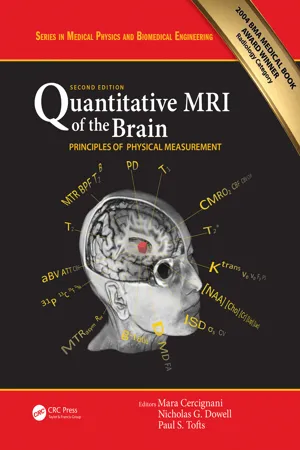
Quantitative MRI of the Brain
Principles of Physical Measurement, Second edition
- 342 pages
- English
- ePUB (mobile friendly)
- Available on iOS & Android
Quantitative MRI of the Brain
Principles of Physical Measurement, Second edition
About this book
Building on the success of the first edition of this book, the winner of the 2004 British Medical Association Radiology Medical Book Competition, Quantitative MRI of the Brain: Principles of Physical Measurement gives a unique view on how to use an MRI machine in a new way. Used as a scientific instrument it can make measurements of a myriad of physical and biological quantities in the human brain and body. For each small tissue voxel, non-invasive information monitors how tissue changes with disease and responds to treatment.
The book opens with a detailed exposition of the principles of good practice in quantification, including fundamental concepts, quality assurance, MR data collection and analysis and improved study statistical power through minimised instrumental variation. There follow chapters on 14 specific groups of quantities: proton density, T1, T2, T2*, diffusion, advanced diffusion, magnetisation transfer, CEST, 1H and multi-nuclear spectroscopy, DCE-MRI, quantitative fMRI, arterial spin-labelling and image analysis, and finally a chapter on the future of quantification. The physical principles behind each quantity are stated, followed by its biological significance. Practical techniques for measurement are given, along with pitfalls and examples of clinical applications.
This second edition of this indispensable 'how to' manual of quantitative MR shows the MRI physicist and research clinician how to implement these techniques on an MRI scanner to understand more about the biological processes in the patient and physiological changes in healthy controls. Although focussed on the brain, most techniques are applicable to characterising tissue in the whole body.
This book is essential reading for anyone who wants to use the gamut of modern quantitative MRI methods to measure the effects of disease, its progression, and its response to treatment.
Features:
- The first edition was awarded the book prize for Radiology by the British Medical Association in 2004
- Written by an authority in the field: Professor Tofts has an international reputation for quantification in MRI
-
Gives specific 'how to' information for implementation of MRI measurement sequence techniques
Frequently asked questions
- Essential is ideal for learners and professionals who enjoy exploring a wide range of subjects. Access the Essential Library with 800,000+ trusted titles and best-sellers across business, personal growth, and the humanities. Includes unlimited reading time and Standard Read Aloud voice.
- Complete: Perfect for advanced learners and researchers needing full, unrestricted access. Unlock 1.4M+ books across hundreds of subjects, including academic and specialized titles. The Complete Plan also includes advanced features like Premium Read Aloud and Research Assistant.
Please note we cannot support devices running on iOS 13 and Android 7 or earlier. Learn more about using the app.
Information
In this chapter, concepts of quantitative magnetic resonance imaging (qMRI) are introduced. The traditions of measurement science and MRI meet in qMRI. MRI has undergone a paradigm shift, as a sophisticated device for visualisation within the brain also offers the option for high-quality measurement, giving access to biological and physiological information, often at the microstructural level. qMRI can measure the effects of disease and the response to treatment. In clinical trials, it is often used as an objective and early indicator of treatment efficacy. The long tradition of scientific measurement is followed to the invention of MRI. The ‘longitude problem’ in the 1700s posed a similar scientific challenge to that of qMRI – how to develop a technology that would have a dramatic impact on human well-being. Principles of good study design are laid out; attention to measurement error (the instrumental standard deviation) can enormously reduce the size and cost of a study. A table of recommended MRI books is given in this chapter.
Table of contents
- Cover
- Title Page
- Copyright Page
- Table of Contents
- Foreword
- Foreword to the First Edition
- Editors
- Contributors
- Introduction
- Introduction to the First Edition
- 1 Concepts: Measurement in MRI
- 2 Measurement Process: MR Data Collection and Image Analysis
- 3 Quality Assurance: Accuracy, Precision, Controls and Phantoms
- 4 PD: Proton Density of Tissue Water
- 5 T1: Longitudinal Relaxation Time
- 6 T2: Transverse Relaxation Time
- 7 T2*: Susceptibility Weighted Imaging and Quantitative Susceptibility Mapping
- 8 D: The Diffusion of Water (DTI)
- 9 Advanced Diffusion Models
- 10 MT: Magnetisation Transfer
- 11 CEST: Chemical Exchange Saturation Transfer
- 12 MRS: 1H Spectroscopy
- 13 Multinuclear MR Imaging and Spectroscopy
- 14 T1-Weighted DCE MRI
- 15 Functional and Metabolic MRI
- 16 ASL: Blood Perfusion Measurement Using Arterial Spin Labelling
- 17 Image Analysis
- 18 Future of Quantitative MRI
- Appendix A: Greek Alphabet for Scientific Use
- Appendix B: MRI Abbreviations and Acronyms
- Index